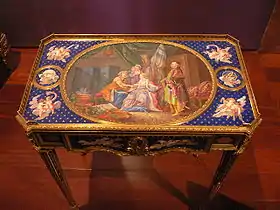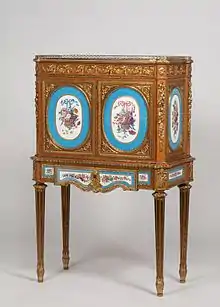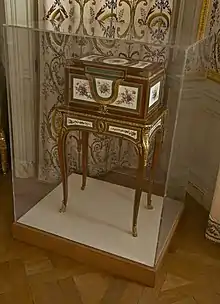Martin Carlin
Martin Carlin (c. 1730–1785) was a Parisian ébéniste (cabinet-maker), born at Freiburg, who was received as Master Ébéniste at Paris on 30 July 1766. Renowned for his "graceful furniture mounted with Sèvres porcelain",[1] Carlin fed into the luxury market of eighteenth-century decorative arts, where porcelain-fitted furniture was considered among "the most exquisite furnishings"[2] within the transitional and neoclassical styles. Carlin's furniture was popular amongst the main great dealers, including Poirier, Daguerre, and Darnault, who sold his furniture to Marie Antoinette and many amongst the social elite class. He died on 6 March 1785.

Work life
Carlin worked at first in the shop of Jean-François Oeben, whose sister he married.[3] The marriage contract reveals that "Carlin was still a day-worker living on the quai des Célestins".[4] Yet soon after Oeben's death, Carlin started to sell furniture to the marchands-merciers when setting up independently in the Faubourg Saint-Antoine. This was however an unfashionable quarter of Paris, where few of his wealthy clientele would have penetrated. Therefore, Carlin found it necessary to sell his works exclusively to marchands-merciers such as Simon-Philippe Poirier[5] and his partner Dominique Daguerre, who acted as decorative-designers. It was only through these entrepreneurs that Carlin could acquire the Sèvres porcelain plaques that decorated many of his pieces. His earliest such pieces can be dated by the marks on their porcelain to 1766; they followed designs supplied by the dealer Poirier. The great dealers also possessed an expansive network of the monarchy and much of the nobility, and thus sold Carlin's furniture to figures such as, Marie Antoinette, the comte de Provence, the comte d'Artois, Louis XV's daughters, the mesdames de France, Madame du Barry, and the duchesse de Mazarin.
For 12 years after becoming Master Ebéniste, he made porcelain-mounted furniture for Poirier and after 1778, he fed into the popular taste for exotic, 'oriental' designs and materials, and therefore started to produce sumptuous pieces in Japanese lacquer.
Collection

Although Martin Carlin made some larger pieces— secrétaires à abattant (drop-front secretary desks), tables, and commodes— he is best known for refined small furnishings in the neoclassical taste, some of them veneered with cut up panels of Chinese lacquer, which he would also have received from the hands of the marchands-merciers.
Bonheur du jour (Table à gradin dite)
- Bonheur du jour, 1765, Bowes Museum, UK
- Bonheur du jour, 1766, Musée Nissim de Camondo, France
- Bonheur du jour, 1768, Boughton House, UK
- Bonheur du jour, 1768, delivered to the Comtesse du Barry, The Metropolitan Museum of Art, United States
- Bonheur du jour, 1769, The Metropolitan Museum of Art, United States
- Bonheur du jour, 1770, The Metropolitan Museum of Art, United States
- Bonheur du jour, 1770, The Huntington Library, United States
- Bonheur du jour, 1771, The Huntington Library, United States
- Bonheur du jour, 1774, The Metropolitan Museum of Art, United States
Bureau plat (Writing table)
- Bureau plat, 1778, delivered to the Grand Duchess Maria Feodorovna and Grand Duke Paul Petrovich of Russia for the Palace of Pavlosk, Getty Museum, United States
Cabinet
- Cabinet, c. 1783, Royal Collection, UK
Coffret à bijoux
- Coffret à bijoux, 1770, delivered to Marie-Antoinette for the Petit Triannon, Château de Versailles, France
- Coffret à bijoux, c. 1770, delivered to the Comtesse du Barry, The Metropolitan Museum of Art, United States
- Coffret à bijoux, c. 1774, delivered to the Grand Duchess Maria Feodorovna and Grand Duke Paul Petrovich of Russia for the Palace of Pavlosk, The Detroit Institute of Arts, United States
- Coffret à bijoux, c. 1775, The Metropolitan Museum of Art, United States
Coffret à bijoux, c. 1775, The Metropolitan Museum of Art, United States

Commode à vantaux (Commode with doors)
- Commode à vantaux, c. 1778, inset with Pietra Dure panels (one of Carlin's greatest examples), Royal Collection, UK
Encoignure (Corner cabinet)
- Pair of Encoignures, 1772, Wallace Collection, UK
Music-stand
- Music-stand and writing table, c. 1775, Waddesdon Manor, UK
- Music-stand, 1770-75, Getty Museum, United States
Music-stand and writing-table
- Music-stand and writing-table, 1786, given by Marie-Antoinette to Mrs William Eden (later Lady Auckland), V&A, UK
Reading stand
- Reading stand, c. 1780, V&A, UK
Secrétaire
- Secrétaire, 1775, Getty Museum, United States
- Secrétaire, 1776, Wallace Collection, UK
- Secrétaire, 1776-77, Getty Museum, United States
Secrétaire à abattant
- Secrétaire à abattant, 1776, Waddesdon Manor, UK
- Secrétaire à abattant, 1770-80, V&A, UK
Table à ouvrage
- Table à ouvrage, 1770. delivered to the duchesse de Mazarin in 1779 for her dressing room, Getty Museum, United States
- Table à ouvrage, 1773, Getty Museum, United States
- Table à ouvrage, 1775, V&A, UK
- Table à ouvrage, 1783-84, Wallace Collection, UK
- Table à ouvrage, 1786, given by Marie-Antoinette to Mrs William Eden (later Lady Auckland), V&A, UK
See also
Notes
- "Drop-front desk (secrétaire à abattant or secrétaire en cabinet), the Met". Retrieved 29 Nov 2018.
- Myers, Mary L. French Architectural and Ornament Drawings of the Eighteenth Century. New York: Metropolitan Museum of Art. p. 196.
- When Oeben died in 1763, Carlin, who was living nearby, was one of his creditors (Eriksen 1974:159).
- "Antiquités Fouqet". Retrieved 29 Nov 2018.
- Other ébénistes working for Poirier were Roger Vandercruse Lacroix and Bernard II van Risamburgh
References
- Svend Eriksen, Early Neo-Classicism in France pp 159 (bio.)
Further reading
- Parker, James & Le Corbeiller, Clare (1979). A Guide to the Wrightsman Galleries at the Metropolitan Museum of Art. New York: The Metropolitan Museum of Art. ISBN 0-87099-186-8.CS1 maint: multiple names: authors list (link) (see index: p. 127-128; illustrations: p. 28, 50, 60-61)
External links
| Wikimedia Commons has media related to Martin Carlin. |
- (Getty Museum): Martin Carlin
- (Metropolitan Museum of Art) Bonheur-du-jour with Sèvres plaques, 1768
- (Detroit Institute of Arts) Jewel Cabinet, about 1774, accession #71.196
- (Royal Collection) Commode, ca 1778, with panels of pietra dura.
- (Waddesdon Manor): Martin Carlin
- YouTube, Combined music stand and writing table made by Martin Carlin, 1775